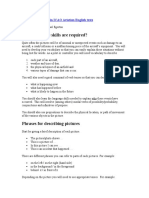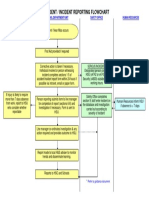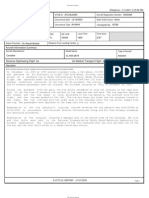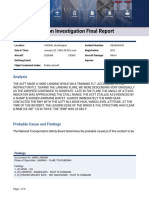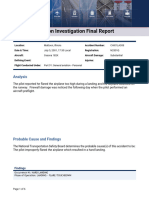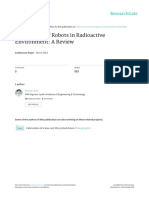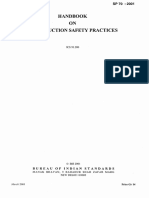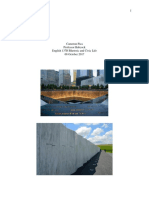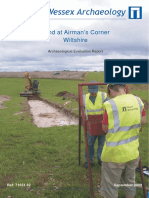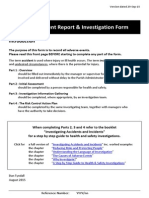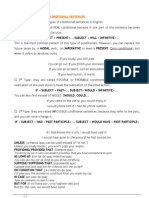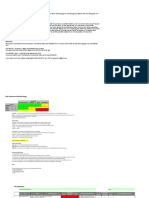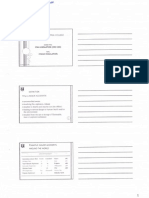NTSB BAC 081113 Factual
NTSB BAC 081113 Factual
Uploaded by
bombardierwatchCopyright:
Available Formats
NTSB BAC 081113 Factual
NTSB BAC 081113 Factual
Uploaded by
bombardierwatchCopyright
Available Formats
Share this document
Did you find this document useful?
Is this content inappropriate?
Copyright:
Available Formats
NTSB BAC 081113 Factual
NTSB BAC 081113 Factual
Uploaded by
bombardierwatchCopyright:
Available Formats
This space for binding
National Transportation Safety Board NTSB ID: DCA09FA011 Aircraft Registration Number: N8698A
FACTUAL REPORT Occurrence Date: 11/13/2008 Most Critical Injury: Minor
AVIATION Occurrence Type: Accident Investigated By: NTSB
Location/Time
Nearest City/Place State Zip Code Local Time Time Zone
Detroit MI 48242 0545 EST
Airport Proximity: On Airport/Airstrip Distance From Landing Facility:
Aircraft Information Summary
Aircraft Manufacturer Model/Series Type of Aircraft
BOMBARDIER INC CL-600-2B19 Airplane
Revenue Sightseeing Flight: No Air Medical Transport Flight: No
Narrative
Brief narrative statement of facts, conditions and circumstances pertinent to the accident/incident:
On November 14, 2008, at 0545 eastern standard time, Pinnacle Airlines Inc., dba Northwest Airlink,
flight 2544, a Bombardier CL-600-2B19 (registration N8698A), equipped with CF34-3B1 engines, was
involved in a collision during taxi with a Delta Airlines tug with a small luggage cart attached.
The scheduled, domestic passenger flight, operated under the provisions of Title 14 CFR Part 121,
departed Gerald R. Ford International Airport (GRR), Grand Rapids, Michigan and landed at Detroit
Metro Wayne County Airport (DTW), Detroit, Michigan. The tug driver received minor injuries but
none of the 17 passengers, two pilots and 1 flight attendant were injured. The airplane was
substantially damaged. The weather observation in effect at the time of the accident was reported
to be winds at 170 and 8 knots, visibility of 4 miles in fog, and overcast clouds at 500 feet. The
temperature was reported as 9 degrees Celsius. It was dark with light rain at the time of the
accident.
According to the accident captain, on the inbound flight to DTW they landed on runway 22L. The
flight was instructed by ground control to taxi via taxiway Kilo and Quebec 3 and to hold short of
taxiway Quebec. The airplane light switches were configured with the navigation lights on,
anti-collision light on, wing inspection lights on, and taxi/recognition lights on. The flight
contacted ramp control and was cleared to taxi to gate C7 via Quebec, going from north to south.
According to the Northwest Airlines ramp controller, when he looked out he could clearly see the
airplane as it had all the "normal taxi lights on." Usually, all traffic goes from south to north
but this type of clearance is given late at night or early in the morning when ground traffic is
light.
The captain stated that he did not see any ground vehicles in close proximity to the airplane as he
prepared to turn into the gate. According to the captain, they were "moving at a crawl" toward
gate C7 when the airplane was struck on the left side. He requested crash, fire, and rescue (CFR)
personnel and began following the instructions of the fire commander.
The ramp agent's [tug driver] normal shift consisted of four 10-hour days. He was starting the
second day of the four day work week when the accident occurred. The ramp agent stated that he
arrived at work in the "B/C" concourse about 0515, had some coffee, and saw that he was scheduled
as a "baggage runner" that day. He took his radio and his lunch box to his tug, and drove to the
bag room in the "A" concourse.
There were a couple of last-minute bags that needed to be delivered to a Delta Airlines flight that
was departing at 0555 for Atlanta, Georgia. He placed the bags in the cart behind his tug and
began driving back toward the "B/C" concourse. He drove on one of the "zipper" roads that goes
between the "A" and the "B/C" concourses. It was dark and there was a "medium, steady" rain
falling. The left side of his tug was open and the right side was covered with a fabric zip-on
cover with a clear plastic panel for a window. He had his windshield wipers on. He did not see
any traffic along the way, but he could see the "C" concourse directly in front of him, and it was
FACTUAL REPORT - AVIATION Page 1
This space for binding
National Transportation Safety Board NTSB ID: DCA09FA011
FACTUAL REPORT Occurrence Date: 11/13/2008
AVIATION Occurrence Type: Accident
Narrative (Continued)
"all lit up." As he proceeded across an intersecting taxiway, he heard airplane engines nearby,
and was surprised. He was not sure if he stepped on the brakes, but he remembered seeing a glimpse
of an airplane fuselage immediately before hearing a loud "crunch" noise. He did not see any
lights from the airplane. He said that airplanes "did not often" taxi to the south on that
taxiway; they usually went north. He had not reached the intersection for the North/South "zipper"
road when he struck the airplane.
The tug struck the plane about half way down the left wing with the tug ending up near the
wing-to-fuselage fairing. The tug was dragged approximately 25 feet before the plane stopped. The
ramp agent stated that he was ejected from the tug. His cell phone was found on the ramp
approximately 15 feet away from the tug. The front axle of the tug was damaged but other damage
was reported as cosmetic.
When the ramp agent "came to," he was lying on the tarmac. He thought he must have lost
consciousness for a short time. He saw the airplane and noticed the cabin windows. He stood there
for a few seconds trying to figure out what had happened, and then got his radio from the tug. He
called Comair operations and told them that he had had an accident, and somebody needed to come get
the bags he was carrying in the cart. He called operations again, and told them to "get a lead"
[supervisor] to come to where he was, and to notify airport rescue and fire fighting (ARFF)
personnel of the accident. Right after he made the second call, police, firefighters and other
rescue personnel began arriving. "Six or seven" Mesaba Airlines employees arrived, and one of them
found his cell phone lying on the tarmac. The ramp agent said that his cell phone had been in his
pocket at the time of the accident. Company policy does not allow him to eat, drink, smoke, or use
the telephone while he is performing his duties.
Updated on Nov 10 2009 12:54PM
FACTUAL REPORT - AVIATION Page 1a
This space for binding
NTSB ID: DCA09FA011
National Transportation Safety Board
FACTUAL REPORT Occurrence Date: 11/13/2008
AVIATION Occurrence Type: Accident
Landing Facility/Approach Information
Airport Name Airport ID: Airport Elevation Runway Used Runway Length Runway Width
Detroit Metropolitan Wayne Cou DTW 645 Ft. MSL N/A
Runway Surface Type:
Runway Surface Condition:
Approach/Arrival Flown: Unknown
VFR Approach/Landing: Unknown
Aircraft Information
Aircraft Manufacturer Model/Series Serial Number
BOMBARDIER INC CL-600-2B19 7698
Airworthiness Certificate(s): Transport
Landing Gear Type: Tricycle
Amateur Built Acft? No Number of Seats: 55 Certified Max Gross Wt. LBS Number of Engines: 2
Engine Type: Engine Manufacturer: Model/Series: Rated Power:
- Aircraft Inspection Information
Type of Last Inspection Date of Last Inspection Time Since Last Inspection Airframe Total Time
Continuous Airworthiness 09/2008 Hours 14008 Hours
- Emergency Locator Transmitter (ELT) Information
ELT Installed?/Type Yes / Unknown ELT Operated? No ELT Aided in Locating Accident Site? No
Owner/Operator Information
Registered Aircraft Owner Street Address
299 S MAIN ST 12TH FLOOR
WELLS FARGO BANK NORTHWEST NA TRUSTEE City State Zip Code
SALT LAKE CITY UT 84111
Street Address
Operator of Aircraft 299 S MAIN ST 12TH FLOOR
City State Zip Code
WELLS FARGO BANK NORTHWEST NA TRUSTEE
SALT LAKE CITY UT 84111
Operator Does Business As: Northwest Airlink Operator Designator Code: FLG
- Type of U.S. Certificate(s) Held:
Air Carrier Operating Certificate(s): Flag Carrier/Domestic
Operating Certificate: Operator Certificate:
Regulation Flight Conducted Under: Part 121: Air Carrier
Type of Flight Operation Conducted: Scheduled; Domestic; Passenger Only
FACTUAL REPORT - AVIATION Page 2
This space for binding
National Transportation Safety Board NTSB ID: DCA09FA011
FACTUAL REPORT Occurrence Date: 11/13/2008
AVIATION Occurrence Type: Accident
First Pilot Information
Name City State Date of Birth Age
On File On File On File 44
Sex: M Seat Occupied: Left Occupational Pilot? Yes Certificate Number:
Certificate(s): Airline Transport
Airplane Rating(s): Multi-engine Land
Rotorcraft/Glider/LTA: None
Instrument Rating(s): Airplane
Instructor Rating(s): Airplane Single-engine; Instrument Airplane
Current Biennial Flight Review? 09/2008
Medical Cert.: Class 1 Medical Cert. Status: With Waivers/Limitations Date of Last Medical Exam: 07/2008
This Make Airplane Airplane Instrument Lighter
All A/C
- Flight Time Matrix and Model Single Engine Mult-Engine
Night
Actual Simulated
Rotorcraft Glider
Than Air
Total Time 5472 2022 1462 4010
Pilot In Command(PIC) 3967 2022
Instructor
Instruction Received
Last 90 Days 182
Last 30 Days 72
Last 24 Hours 7
Seatbelt Used? Yes Shoulder Harness Used? Yes Toxicology Performed? No Second Pilot? Yes
Flight Plan/Itinerary
Type of Flight Plan Filed: IFR
Departure Point State Airport Identifier Departure Time Time Zone
Grand Rapids MI GRR 0453 EST
Destination State Airport Identifier
Same as Accident/Incident Location DTW
Type of Clearance: IFR
Type of Airspace:
Weather Information
Source of Wx Information:
National Weather Service
FACTUAL REPORT - AVIATION Page 3
This space for binding
National Transportation Safety Board NTSB ID: DCA09FA011
FACTUAL REPORT Occurrence Date: 11/13/2008
AVIATION Occurrence Type: Accident
Weather Information
WOF ID Observation Time Time Zone WOF Elevation WOF Distance From Accident Site Direction From Accident Site
DTW 0853 CST Ft. MSL 0 NM Deg. Mag.
Sky/Lowest Cloud Condition: Ft. AGL Condition of Light: Night
Lowest Ceiling: Overcast 500 Ft. AGL Visibility: 4 SM Altimeter: 29.81 "Hg
Temperature: 9 °C Dew Point: 8 °C Weather Conditions at Accident Site: Instrument Conditions
Wind Direction: 170 Wind Speed: 8 Wind Gusts:
Visibility (RVR): Ft. Visibility (RVV) SM
Precip and/or Obscuration:
Accident Information
Aircraft Damage: Substantial Aircraft Fire: None Aircraft Explosion None
- Injury Summary Matrix Fatal Serious Minor None TOTAL
First Pilot 1 1
Second Pilot 1 1
Student Pilot
Flight Instructor
Check Pilot
Flight Engineer
Cabin Attendants 1 1
Other Crew
Passengers 17 17
- TOTAL ABOARD - 20 20
Other Ground 1 1
- GRAND TOTAL - 1 20 21
FACTUAL REPORT - AVIATION Page 4
This space for binding
NTSB ID: DCA09FA011
National Transportation Safety Board
FACTUAL REPORT Occurrence Date: 11/13/2008
AVIATION Occurrence Type: Accident
Administrative Information
Investigator-In-Charge (IIC)
Robert P. Benzon
Additional Persons Participating in This Accident/Incident Investigation:
Robert Drake
Federal Aviation Administration, AAI-100
Washington, DC
FACTUAL REPORT - AVIATION Page 5
You might also like
- Aaliyah Crash ReportDocument5 pagesAaliyah Crash Reportalphatango1100% (2)
- AW139 AMPI Chapter 5 Issue 10 Dated 2016-10-25Document154 pagesAW139 AMPI Chapter 5 Issue 10 Dated 2016-10-25anony8103100% (2)
- Fear The Walking Dead ǁ 1x01 ǁ PilotDocument55 pagesFear The Walking Dead ǁ 1x01 ǁ PilotAlex FulkroadNo ratings yet
- Describing Pictures in ICAO Aviation EnglishDocument2 pagesDescribing Pictures in ICAO Aviation Englishkopa1982No ratings yet
- Accident InvestigationDocument10 pagesAccident InvestigationHeli Senn Ventenilla100% (1)
- Accident and Incident Reporting Flow ChartDocument1 pageAccident and Incident Reporting Flow ChartKhyle Laurenz Duro100% (1)
- NTSB BAC 021104 FactualDocument5 pagesNTSB BAC 021104 FactualbombardierwatchNo ratings yet
- NTSB LJ 100105 FactualDocument6 pagesNTSB LJ 100105 FactualbombardierwatchNo ratings yet
- NTSB BAC 041027 FactualDocument5 pagesNTSB BAC 041027 FactualbombardierwatchNo ratings yet
- NTSB BAC 031214 FactualDocument5 pagesNTSB BAC 031214 FactualbombardierwatchNo ratings yet
- NTSB BAC 031202 FactualDocument5 pagesNTSB BAC 031202 FactualbombardierwatchNo ratings yet
- NTSB BAC 030507 FactualDocument5 pagesNTSB BAC 030507 FactualbombardierwatchNo ratings yet
- NTSB BAC 060415 FactualDocument5 pagesNTSB BAC 060415 FactualbombardierwatchNo ratings yet
- NTSB LJ 040904 FactualDocument5 pagesNTSB LJ 040904 FactualbombardierwatchNo ratings yet
- NTSB LJ 010204 FactualDocument5 pagesNTSB LJ 010204 FactualbombardierwatchNo ratings yet
- Lax 92 Fa 206Document5 pagesLax 92 Fa 206Richard StittNo ratings yet
- NTSB BAC 980507 FactualDocument6 pagesNTSB BAC 980507 FactualbombardierwatchNo ratings yet
- NTSB BAC 100928 PreliminaryDocument3 pagesNTSB BAC 100928 PreliminarybombardierwatchNo ratings yet
- NTSB BAC 000917 FactualDocument5 pagesNTSB BAC 000917 FactualbombardierwatchNo ratings yet
- NTSB BAC 030622 FactualDocument5 pagesNTSB BAC 030622 FactualbombardierwatchNo ratings yet
- NTSB BAC 001023 FactualDocument6 pagesNTSB BAC 001023 FactualbombardierwatchNo ratings yet
- NTSB BAC 040721 FactualDocument6 pagesNTSB BAC 040721 FactualbombardierwatchNo ratings yet
- NTSB BAC 080130 FactualDocument1 pageNTSB BAC 080130 FactualbombardierwatchNo ratings yet
- NTSB BAC 090927 PreliminaryDocument3 pagesNTSB BAC 090927 PreliminarybombardierwatchNo ratings yet
- NTSB BAC 980309 FactualDocument5 pagesNTSB BAC 980309 FactualbombardierwatchNo ratings yet
- NTSB LJ 000312 FactualDocument6 pagesNTSB LJ 000312 FactualbombardierwatchNo ratings yet
- NTSB LJ 010607 FactualDocument5 pagesNTSB LJ 010607 FactualbombardierwatchNo ratings yet
- NTSB BAC 070213 FactualDocument5 pagesNTSB BAC 070213 FactualbombardierwatchNo ratings yet
- NTSB LJ 051026 FactualDocument1 pageNTSB LJ 051026 FactualbombardierwatchNo ratings yet
- NTSB BAC 090804 PreliminaryDocument3 pagesNTSB BAC 090804 PreliminarybombardierwatchNo ratings yet
- NTSB Report On Austin Airplane AttackDocument5 pagesNTSB Report On Austin Airplane AttackKUTNewsNo ratings yet
- NTSB BAC 080130 Probable CauseDocument2 pagesNTSB BAC 080130 Probable CausebombardierwatchNo ratings yet
- NTSB BAC 090301 PreliminaryDocument3 pagesNTSB BAC 090301 PreliminarybombardierwatchNo ratings yet
- NTSB BAC 070412 Probable CauseDocument2 pagesNTSB BAC 070412 Probable CausebombardierwatchNo ratings yet
- NTSB BAC 020104 FactualDocument5 pagesNTSB BAC 020104 FactualbombardierwatchNo ratings yet
- NTSB BAC 071216 Probable CauseDocument2 pagesNTSB BAC 071216 Probable CausebombardierwatchNo ratings yet
- NTSB BAC 091218 FactualDocument1 pageNTSB BAC 091218 FactualbombardierwatchNo ratings yet
- NTSB LJ 070823 Probable CauseDocument2 pagesNTSB LJ 070823 Probable CausebombardierwatchNo ratings yet
- NTSB BAC 071216 Factual - N470ZWDocument12 pagesNTSB BAC 071216 Factual - N470ZWbombardierwatchNo ratings yet
- NTSB BAC 030507 Probable CauseDocument2 pagesNTSB BAC 030507 Probable CausebombardierwatchNo ratings yet
- NTSB BAC 050521 FactualDocument1 pageNTSB BAC 050521 FactualbombardierwatchNo ratings yet
- 1994 06 29 UsaDocument8 pages1994 06 29 Usajer jerNo ratings yet
- NTSB BAC 050311 FactualDocument14 pagesNTSB BAC 050311 FactualbombardierwatchNo ratings yet
- NTSB LJ 010114 Probable CauseDocument3 pagesNTSB LJ 010114 Probable CausebombardierwatchNo ratings yet
- NTSB BAC 041027 Probable CauseDocument2 pagesNTSB BAC 041027 Probable CausebombardierwatchNo ratings yet
- NTSB LJ 011210 FactualDocument12 pagesNTSB LJ 011210 FactualbombardierwatchNo ratings yet
- NTSB LJ 061226 Probable CauseDocument2 pagesNTSB LJ 061226 Probable CausebombardierwatchNo ratings yet
- NTSB BAC 990816 FactualDocument8 pagesNTSB BAC 990816 FactualbombardierwatchNo ratings yet
- NTSB LJ 980523 Probable CauseDocument2 pagesNTSB LJ 980523 Probable CausebombardierwatchNo ratings yet
- NTSB LJ 990330 Probable CauseDocument2 pagesNTSB LJ 990330 Probable CausebombardierwatchNo ratings yet
- Metro LinerDocument318 pagesMetro Linergobo3000100% (1)
- NTSB Prelim Report Lantana Plane CrashDocument3 pagesNTSB Prelim Report Lantana Plane CrashSkyler ShepardNo ratings yet
- Report - CEN21LA085 - 102403 - 12162022 11913 AMDocument5 pagesReport - CEN21LA085 - 102403 - 12162022 11913 AMFiron FironNo ratings yet
- NTSB BAC 081214 Probable CauseDocument2 pagesNTSB BAC 081214 Probable CausebombardierwatchNo ratings yet
- NTSB BAC 050311 Probable CauseDocument3 pagesNTSB BAC 050311 Probable CausebombardierwatchNo ratings yet
- NTSB BAC 050402 FactualDocument1 pageNTSB BAC 050402 FactualbombardierwatchNo ratings yet
- Report - SEA84IA042 - 39836 - 8 - 10 - 2024 8 - 37 - 54 AMDocument5 pagesReport - SEA84IA042 - 39836 - 8 - 10 - 2024 8 - 37 - 54 AMlovro.bracevicNo ratings yet
- NTSB LJ 080221 Probable CauseDocument2 pagesNTSB LJ 080221 Probable CausebombardierwatchNo ratings yet
- NTSB LJ 040713 Probable CauseDocument2 pagesNTSB LJ 040713 Probable CausebombardierwatchNo ratings yet
- NTSB BAC 050829 Probable CauseDocument2 pagesNTSB BAC 050829 Probable CausebombardierwatchNo ratings yet
- NTSB Preliminary ReportDocument3 pagesNTSB Preliminary ReportAnonymous xvHO5CigFNo ratings yet
- Report - CHI01LA308 - 53699 - 8 - 10 - 2024 8 - 38 - 42 AMDocument6 pagesReport - CHI01LA308 - 53699 - 8 - 10 - 2024 8 - 38 - 42 AMlovro.bracevicNo ratings yet
- NTSB BAC 100224 Probable CauseDocument2 pagesNTSB BAC 100224 Probable CausebombardierwatchNo ratings yet
- NTSB Prelim Report PapillonDocument3 pagesNTSB Prelim Report PapillonBoulder City ReviewNo ratings yet
- Air Crash Investigations - Cracked Solder Joint - The Crash of Indonesia Air Asia Flight 8501From EverandAir Crash Investigations - Cracked Solder Joint - The Crash of Indonesia Air Asia Flight 8501No ratings yet
- BRP Recalls Snowmobiles Due To Explosion HazardDocument4 pagesBRP Recalls Snowmobiles Due To Explosion HazardbombardierwatchNo ratings yet
- Bombardier Recreational Products Inc. Recalls Snowmobiles Due To Crash and Fire HazardsDocument3 pagesBombardier Recreational Products Inc. Recalls Snowmobiles Due To Crash and Fire HazardsbombardierwatchNo ratings yet
- CPSC, Bombardier Recreational Products Inc. Announce Recall of All-Terrain VehiclesDocument3 pagesCPSC, Bombardier Recreational Products Inc. Announce Recall of All-Terrain VehiclesbombardierwatchNo ratings yet
- IOTC AIR, LLC v. BOMBARDIER INC. Et Al DocketDocument1 pageIOTC AIR, LLC v. BOMBARDIER INC. Et Al DocketbombardierwatchNo ratings yet
- CPSC, Bombardier Recreational Products Inc. Announce Recall of SnowmobilesDocument5 pagesCPSC, Bombardier Recreational Products Inc. Announce Recall of SnowmobilesbombardierwatchNo ratings yet
- STEWART, ANASTASIA THERESA Et Al v. SUNJET AVIATDKN INC, Et Al DocketDocument60 pagesSTEWART, ANASTASIA THERESA Et Al v. SUNJET AVIATDKN INC, Et Al DocketbombardierwatchNo ratings yet
- CPSC, Bombardier Recreational Products Inc. Announce Recall of Ratchet Winch Kits, Sold As Accessory For SnowmobilesDocument2 pagesCPSC, Bombardier Recreational Products Inc. Announce Recall of Ratchet Winch Kits, Sold As Accessory For SnowmobilesbombardierwatchNo ratings yet
- CPSC, Bombardier Recreational Products Inc., and Deere & Company Announce Recall of ATVsDocument5 pagesCPSC, Bombardier Recreational Products Inc., and Deere & Company Announce Recall of ATVsbombardierwatchNo ratings yet
- SPARTZ, KATHLEEN v. BRP US INC DocketDocument1 pageSPARTZ, KATHLEEN v. BRP US INC DocketbombardierwatchNo ratings yet
- BOMBARDIER, INC. v. HAWAII ISLAND AIR, INC. DocketDocument4 pagesBOMBARDIER, INC. v. HAWAII ISLAND AIR, INC. DocketbombardierwatchNo ratings yet
- FRALEY, DIXIE LEIGH Et Al vs. SUNJET AVIATION INC, Et Al DocketDocument47 pagesFRALEY, DIXIE LEIGH Et Al vs. SUNJET AVIATION INC, Et Al DocketbombardierwatchNo ratings yet
- BULMAN v. BOMBARDIER, INC., Et Al 2nd DocketDocument6 pagesBULMAN v. BOMBARDIER, INC., Et Al 2nd DocketbombardierwatchNo ratings yet
- SWINGLE v. EPPS AIR SERVICE, Et Al DocketDocument2 pagesSWINGLE v. EPPS AIR SERVICE, Et Al DocketbombardierwatchNo ratings yet
- SWINGLE v. EPPS AIR SERVICE, Et Al Bombardier ResponseDocument11 pagesSWINGLE v. EPPS AIR SERVICE, Et Al Bombardier ResponsebombardierwatchNo ratings yet
- PESANTE v. BOMBARDIER TRANSPORTATION ComplaintDocument13 pagesPESANTE v. BOMBARDIER TRANSPORTATION ComplaintbombardierwatchNo ratings yet
- Othello TermsDocument5 pagesOthello Termsapi-300202439No ratings yet
- Magnetic Core Drill (A, B Type) Semi Auto Feed Magnetic Core Drill 2 Speed Magnetic Core Drill 4 Speed Magnetic Core DrillDocument37 pagesMagnetic Core Drill (A, B Type) Semi Auto Feed Magnetic Core Drill 2 Speed Magnetic Core Drill 4 Speed Magnetic Core DrillAntonio JoseNo ratings yet
- A New Pre Crash System For Side Impact ProtectionDocument15 pagesA New Pre Crash System For Side Impact ProtectionSachin SilmanaNo ratings yet
- Application of Robots in Radioactive Environment: A Review: March 2014Document6 pagesApplication of Robots in Radioactive Environment: A Review: March 2014shintoNo ratings yet
- SP70 PDFDocument58 pagesSP70 PDFjashan7785100% (1)
- Aar96 01 111219161022 Phpapp01Document336 pagesAar96 01 111219161022 Phpapp01Gabriel Tudorel Dedu100% (1)
- Physics Experiments - Linear MotionDocument1 pagePhysics Experiments - Linear MotionJose GalvanNo ratings yet
- Crime Detection, Investigation and PreventionDocument11 pagesCrime Detection, Investigation and PreventionVj Lentejas IIINo ratings yet
- Defences and Remedies in TortDocument6 pagesDefences and Remedies in TortDebbz SmythNo ratings yet
- Austroads Guide Road Design Part6 AGRD06 09Document296 pagesAustroads Guide Road Design Part6 AGRD06 09kevin_au18No ratings yet
- BlotterDocument1 pageBlotterDolores PulisNo ratings yet
- Dynamics CompanionDocument191 pagesDynamics CompanionMahendra AbesingheNo ratings yet
- Southern Lines Vs CADocument2 pagesSouthern Lines Vs CAeogyramNo ratings yet
- Rhetorical Analysis EssayDocument7 pagesRhetorical Analysis Essayapi-404878255No ratings yet
- Land at Airman's Corner, WIltshireDocument60 pagesLand at Airman's Corner, WIltshireWessex ArchaeologyNo ratings yet
- Appendix C (Monorail)Document107 pagesAppendix C (Monorail)arshiep100% (1)
- 2015 08 26 Adverse Event Report and Investigation FormDocument8 pages2015 08 26 Adverse Event Report and Investigation FormSt Mary Redcliffe ChurchNo ratings yet
- Job Safety Analysis (JSA) Worksheet Attachment III PTW No.: - Date IssuedDocument5 pagesJob Safety Analysis (JSA) Worksheet Attachment III PTW No.: - Date Issuedninaami9886No ratings yet
- ConditionalsDocument27 pagesConditionalsIsabel Sotele100% (2)
- Towing ProcedureDocument8 pagesTowing ProcedureAhmadFaisalNo ratings yet
- Ski - Risk Assessment ToolDocument20 pagesSki - Risk Assessment ToolFreddy LiminNo ratings yet
- CIMAH RegulationDocument18 pagesCIMAH RegulationAldric Tinker Toyad100% (3)
- Fake Navigation ControlDocument4 pagesFake Navigation ControlRahmatia Wulan DariNo ratings yet
- Mediclinic Weekly Progress Report No 29Document27 pagesMediclinic Weekly Progress Report No 29Julius Ceasar SanorjoNo ratings yet
- 1996 - Eastwind 517Document15 pages1996 - Eastwind 517Carlos VarrentiNo ratings yet



